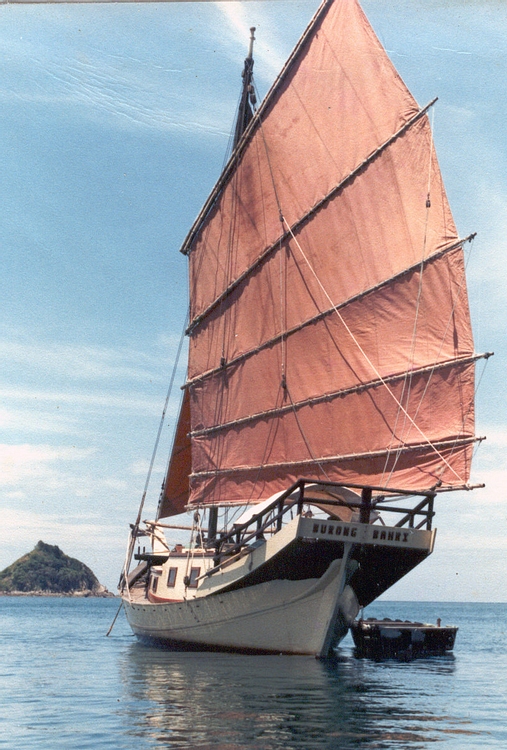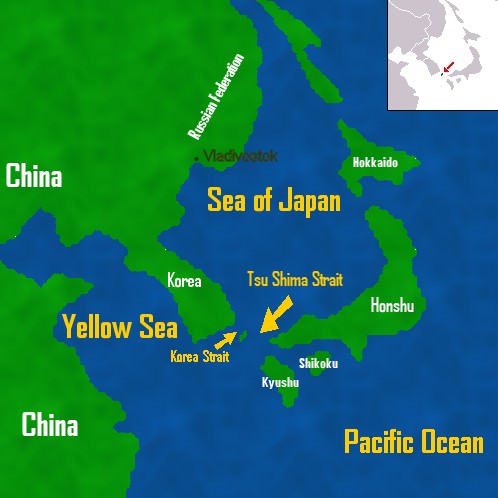Seven Lucky Gods › Jang Bogo » Ancient origins
Articles and Definitions › Contents
- Seven Lucky Gods › Ancient History
- Jang Bogo › Who Was
Ancient civilizations › Historical and archaeological sites
Seven Lucky Gods › Ancient History
Definition and Origins

In Japanese folklore the Shichifukujin are the Seven Lucky Gods who may also be known as the Seven Gods of Happiness or the Seven Gods of Good Fortune. The seven gods are in fact of diverse origin as some are originally from Buddhism, some are from Shinto, and still others come from Chinese tradition. There are also varying traditions of which gods actually make up the group but the established seven are: Ebisu, Daikoku, Benten, Bishamon, Fukurokuju, Jurojin, and Hotei. Although each generally represents good fortune, they also have particular characteristics and associations.
THE SEVEN GODS
Ebisu - is probably of Japanese origin, is a Shinto god, the patron of work, specifically tradesmen and fishermen, and is usually depicted wearing Japanese costume and headdress. He has a portly figure, large swollen earlobes, and he usually has a fishing rod in his right hand whilst in his left is a large, freshly caught fish - a tai (sea bream, sea bass or dorado), itself a symbol of good luck. Perhaps due to his successful catch, Ebisu is always smiling. In later tradition Ebisu is identified with Hiruko, the first offspring of the gods Izanagi and Izananmi. Traditionally, Ebisu is celebrated in an annual feast held on the 20th of October.
Daikoku - is of Japanese origin, is the god of wealth and prosperity, the patron of farmers and leader of the Shichi Fukujin. In his right hand he carries the hammer of riches which can grant wishes and has a large bag of treasures slung over his shoulder. He is dark-skinned, is usually standing or sitting atop two sacks of rice and, like Ebisu, he has a full figure and large earlobes. He is traditionally associated with the Hindu god Shiva and the Buddhist god Mahakala.
Benten (or Benzaiten) - is of Hindu origin and the only one of the group who is female. She is the goddess of love and reasoning. She is usually depicted playing the biwa, a type of lute or guitar, and riding a dragon or sea-dragon to whom she married according to some traditions and, thereby, ended the dragon's attacks on the island of Enoshima. Her special messenger is a white snake and she is often associated with the sea where many of the shrines dedicated to her are located.For Buddhists, she is the patron of wealth, literature, and music, and she is also the embodiment of femininity.
BISHAMON IS THE GOD OF HAPPINESS & WAR, THE PATRON OF WARRIORS & PROTECTOR OF THE RIGHTEOUS.
Bishamon (or Bishamonten or Tamon) - is the god of happiness and war, is the patron of warriors and protector of the righteous. He is depicted in full Chinese armour and carrying a lance in his left hand. In his right hand he has a small pagoda building which represents a treasury. Traditionally he is associated with the Hindu and Buddhist deity Kubera or Vaisravana.Shiga, the temple city founded around the 6th century CE, was dedicated to the god in thanks after Shotoku Taishi won a battle at the site.
Fukurokuju - is of Chinese origin but his Japanese name signifies happiness ( fuku ), wealth ( roku ), and longevity ( ju ); he is, therefore, known as the god of wisdom and longevity. Traditionally he is considered to have once been a mortal and lived as Taoist sage and is commonly attributed the power of resurrecting the dead. He is depicted as short in height but with a very high forehead and is usually to be found in the company of a stork or crane.
Jurojin - is also of Chinese origin and likewise god of longevity and wisdom; he is usually represented with a stag at his side, and he carries a long stick to which is attached a scroll containing all the wisdom of the world. Like Fukurokuju, legend states that he once lived on earth as a Taoist sage. He is also represented as an old man with a white beard but wears a scholar's headdress.
Jurojin - is also of Chinese origin and likewise god of longevity and wisdom; he is usually represented with a stag at his side, and he carries a long stick to which is attached a scroll containing all the wisdom of the world. Like Fukurokuju, legend states that he once lived on earth as a Taoist sage. He is also represented as an old man with a white beard but wears a scholar's headdress.
Hotei (or Hotei-osho) - is also originally from China, Hotei represents thrift and philanthropy. He is perhaps the god who is portrayed in the most unflattering light as a fat, bald, and rather unkempt-looking Buddhist monk with a big exposed belly and large swollen earlobes. However, always chuckling and often surrounded by children, he is perhaps the happiest looking of the seven gods and lives up to his Chinese nickname as the 'Laughing Buddha '.

Seven Lucky Gods
REPRESENTATIONS IN ART
Although the gods go back much earlier in time, in Japanese tradition the first representation of the gods as a group of seven is in the 16th century CE in a painting by a member of the Kano family commissioned by Tokugawa Ieyasu (1542-1616 CE).Aside from being represented individually, the Shichifukjin are also shown as a group riding their takara-bune or treasure ship.The gods are a particularly popular subject of Netsuke, the Japanese miniature sculptures carved most often in ivory and precious hardwoods and originally used as toggles.
The Shichifukujin are also popular protagonists in Japanese folk songs, paintings, and theatre, where they often possess objects with magical properties such as a hat that makes the wearer invisible and a purse that is never empty. Even today, posters and pictures of the gods are still popularly believed to bring good luck, and in shops and restaurants their statues remain a common sight.
Jang Bogo › Who Was
Definition and Origins

Jang Bogo (aka Chang Pogo or Gungbok) was a powerful Korean warlord, naval commander, and merchant who came to monopolise maritime trade in northeast Asia to such a degree that he was known as the 'King of the Yellow Sea' during the first half of the 9th century CE. His exploits have gained him a legendary status which he still enjoys in Korea today.
EARLY LIFE
Jang Bogo's life and trading activities are described in the Account of a Pilgrimage to Tang in Search of the Law ( Nyu Tokyuho junrei koki ) by the Japanese scholar-monk Ennin (aka Jikaku, 794-864 CE). The account contains a passage describing a voyage in one of Jang's naval vessels in 840 CE to the Buddhist monastery at Shandong. Amongst other sources are the works of the Chinese poet Du Mu, and it is interesting here to note that, indeed, most of the ancient accounts of Jang's exploits come from Chinese and Japanese sources, indicating his fame throughout East Asia. This has led the historian Kyung Moon Hwang to state, "there might not have been a Korean historical figure better-known outside northeast Asia until the twentieth century" (28).
Jang was born, perhaps in 788 CE, into a modest family in the town of Cheonghae (Wando island), located off the south-west coast of the Unified Silla Kingdom of ancient Korea. In his early career, we are informed that Jang served as an officer in the army of the Tang dynasty, like many of his Silla contemporaries, and fought in the lower Huai River basin of China.
GARRISON COMMANDER AT CHEONGHAE
Returning to Korea in 828 CE, Jang requested from the Silla king permission to establish a garrison at Cheonghae. Jang argued that only a permanent military presence could eradicate the troublesome Chinese pirates which were plaguing the East Asian seas at that time and provide naval escorts for Koreans travelling by sea who were being captured by the pirates and sold into slavery in China. His proposal was accepted by King Heungdeok, and Jang was made its commander, a position he held until 846 CE. It may be that the royal approval was a mere formality as by then Jang already possessed a large private navy of his own, but a fortress was constructed, known as Cheonghaejin, which housed 10,000 soldiers.
FROM HIS BASE, JANG'S NAVAL FLEET COULD CONTROL ALL MARITIME TRADE BETWEEN CHINA, KOREA & JAPANACROSS THE YELLOW & SOUTH SEAS.
From his base, Jang's naval fleet could control all maritime trade between China and Korea across the Yellow Sea and South Sea as well as commerce to and from ancient Japan. Goods shipped would have included precious metals, manufactured goods from furniture to weapons, silk, tea, and ginseng. In addition, the trade network of the time established contact with traders from afar afield as Arabia and east Africa who brought exotic spices, carpets, and animal products.
Once he had cleared the area of piracy, and with his leadership of the Korean community on the Shandong peninsula, Jang established a lucrative monopoly on the region's ceramics trade. He may well have contributed to the popularity of Chinese porcelain in the wider world and facilitated technology improvements in Korea's own potteries. Jang is also credited with establishing the Buddhist temple of Pophwawon and its monastery at Shandong which had 28 monks and nuns. Not only did this meet the religious needs of the Silla expatriates but it also served as his diplomatic and commercial headquarters.

Map of East Asia
SILLA POLITICS & ASSASSINATION
In 839 CE Jang backed Kim Ujing and, attacking the capital of Gyeongju (Kyongju), helped him ascend the throne of the Unified Silla Kingdom as King Sinmu. In gratitude the king gave Jang the impressive title of Grand General of Cheonghae.Unfortunately, Sinmu would only reign for a year, and so Jang sought to maintain his influence at court by having his daughter marry the son of Sinmu's successor, King Munseong to become his second queen. These overtures proved unsuccessful and Jang was murdered in 846 CE by an assassin known as Yeomjang, hired by his aristocratic political rivals who, no doubt, saw him as a commoner who had gained too much power for their own good. The Cheonghae garrison, having served its purpose, was disbanded in 851 CE.
Jang's reputation has lived on, though, not only in the following centuries thanks to ancient writers but also in modern Korea where there has been a renewed interest in national historical heroes. Museums, TV shows, submarines, and even an Antarctic research station have been dedicated to this legendary figure from the golden era when Korea dominated the trade networks of northeast Asia.
This article was made possible with generous support from the British Korean Society.
LICENSE:
Article based on information obtained from these sources:with permission from the Website Ancient History Encyclopedia
Content is available under License Creative Commons: Attribution-NonCommercial-ShareAlike 3.0 Unported. CC-BY-NC-SA License